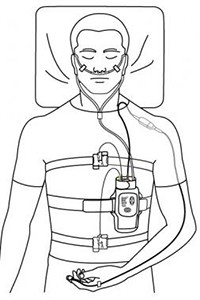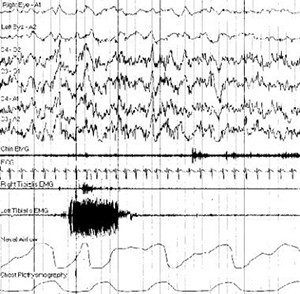Sleep Study
Sleep Study Diagnosis in Nashik – Dr. Mutha Chest & Sleep Center
At Dr. Mutha Chest & Sleep Center, we specialize in advanced Sleep Study Diagnosis in Nashik, helping patients identify and manage sleep-related disorders like Obstructive Sleep Apnea Syndrome (OSAS). Our lab is equipped with modern polysomnography (PSG) tools to assess and record vital sleep-related physiological functions in a controlled, overnight setting.

What is a Sleep Study (Polysomnography)?
Polysomnography (PSG) is considered the gold standard for Sleep Apnea Diagnosis in Nashik. It’s a comprehensive overnight test that records multiple body functions such as brain activity, breathing patterns, blood oxygen levels, heart rate, and body movements during sleep.
PSG helps in diagnosing:
Obstructive Sleep Apnea
Central Sleep Apnea
Mixed Sleep Apnea
REM-related parasomnias
Periodic Limb Movement Disorder
Bruxism
Sleep Hypoventilation
If you’re experiencing excessive daytime sleepiness, loud snoring, pauses in breathing during sleep, or fatigue even after a full night’s rest, a Sleep Study Test in Nashik may be recommended.
Parameters Monitored During Sleep Study
We conduct PSG by simultaneously recording multiple physiological parameters:
EEG (Electroencephalography): Records brain wave activity to determine sleep stages
EOG (Electrooculography): Monitors eye movements to track REM and sleep onset
EMG (Electromyography): Detects chin muscle activity for REM atonia, and anterior tibialis muscle for leg movements
Thermistor & Pressure Transducer: Monitor nasal/oral airflow and identify apneas or hypopneas
Pulse Oximetry: Monitors oxygen saturation
Respiratory Effort Sensors: Track thoracic and abdominal movements
Electrocardiography (ECG): Captures heart rhythm during sleep
Video Monitoring: Helps correlate physical movements with recorded data

Sleep Disorders Diagnosed by PSG
Our Sleep Lab in Nashik helps detect and differentiate between various sleep disorders:
1. Obstructive Sleep Apnea (OSA)
Reduction in airflow >90% lasting at least 10 seconds
Associated with increasing respiratory effort and oxygen desaturation
Diagnosed with both thermistor and pressure transducer data
2. Central Sleep Apnea
Absence of airflow and respiratory effort for >10 seconds
Indicates a dysfunction in the brain’s control over breathing
3. Mixed Apnea
Starts as central (no effort), ends as obstructive (effort returns)
Associated with drop in oxygen saturation
4. Hypopnea
≥30% airflow reduction with ≥3% oxygen desaturation or arousal
Scored as obstructive or central based on effort and airflow changes
5. Periodic Limb Movement Disorder
Repetitive leg jerks (0.5–10 seconds) with a minimum 4 events per hour
Identified using anterior tibialis EMG
6. Cheyne-Stokes Respiration
Cyclic pattern of crescendo-decrescendo breathing
Minimum 3 consecutive cycles with apnea/hypopnea components
7. Sleep-Related Hypoventilation
CO₂ >50 mmHg for >25% of total sleep time
Measured via end-tidal or transcutaneous CO₂ sensors
8. Bruxism
Detected via chin EMG with ≥3 bursts of activity
Commonly associated with stress and sleep arousals
When is a Sleep Study Recommended?
Your pulmonologist may recommend a Sleep Apnea Test in Nashik if you have:
Loud, habitual snoring
Episodes of stopped breathing observed during sleep
Persistent fatigue or sleepiness during the day
Difficulty concentrating
Morning headaches
High blood pressure or arrhythmia
Depression or mood changes
Suspected Obstructive Sleep Apnea or Narcolepsy
We also recommend PSG testing before and after CPAP therapy to evaluate its effectiveness in sleep apnea management.
Why Choose Dr. Mutha Hospital for Sleep Study in Nashik?
Dedicated Sleep Medicine Specialists in Nashik
State-of-the-art PSG technology
NABH-accredited facility with continuous monitoring
Supportive care team for patient comfort
Linked diagnostic services like Pulmonary Function Test (PFT) in Nashik and Bronchoscopy
What to Expect During Your Sleep Study
You’ll be asked to report in the evening
Small sensors will be placed on your head, face, chest, and limbs
Our technicians will monitor your sleep throughout the night
The test is painless and comfortable
You can usually go home the next morning after the test
Note: Avoid caffeine, alcohol, and naps on the day of your test. Take your usual medications unless told otherwise.
Ready to get our medical care? We’re always wait for serve you, Make an Appointment.
Appointment
Our Pricing Packages
- Neurology Care
- Medical Care
- Child & Old Care
- Dental Care
- On-Time Delivery
- Neurology Care
- Medical Care
- Child & Old Care
- Dental Care
- On-Time Delivery
- Neurology Care
- Medical Care
- Child & Old Care
- Dental Care
- On-Time Delivery
